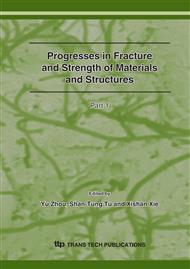p.2061
p.2065
p.2069
p.2073
p.2077
p.2081
p.2085
p.2088
p.2092
Effect of Residual Stress and Weld Metal on Hysteretic Behavior of a Welded Tubular T-Joint
Abstract:
During the welding process to make welded joints, residual stress is inevitably generated and weld metal is used. Welding Residual stress is influenced on the behavior of welded joints under monotonic and cyclic loading. And the weld metals used in welding process have different mechanical characteristics than structural steels. Therefore, to accurately predict the hysteretic behavior of welded joints, the effect of residual stress and weld metal must be investigated. In this paper, the residual stress distribution in a welded tubular T-joint was investigated by carrying out three-dimensional non-steady heat conduction analysis and three-dimensional thermal elastic-plastic analysis. To consider a effect of base metal(SM490) and weld metal(E71T-1), a cyclic plasticity model was formulated based on monotonic and cyclic loading tests. And the formulated model was applied to three-dimensional elastic-plastic finite element analysis. The effect of residual stress and weld metal on hysteretic behavior of a welded tubular T-joint was investigated by carrying out numerical analyses considering residual stress and cyclic plasticity model of base metal and weld metal respectively.
Info:
Periodical:
Pages:
2077-2080
Citation:
Online since:
September 2007
Authors:
Price:
Сopyright:
© 2007 Trans Tech Publications Ltd. All Rights Reserved
Share:
Citation:


